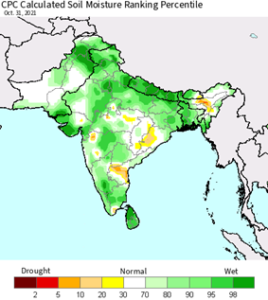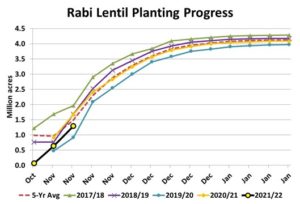Pulse Market Insight #197 NOV 12 2021 | Producers | Pulse Market Insights
Situation in India Worth Watching
It’s that time of year when we start looking more closely at crop outlooks in India. November is the beginning of the rabi season, when Indian farmers plant chickpeas, peas and lentils. Most of the harvest happens in late February to early April. During this season, we track several information pieces to get an idea of crop prospects. Government production estimates don’t show up until later and are of limited value.
The first thing we watch for is the Minimum Support Price for crops purchased by the Indian government. There’s debate about how much influence these MSPs have over Indian farmers’ planting decisions but they have been rising each and every year. For the 2021/22 season, the MSP for chickpeas was raised only 2.5% while the lentil MSP was up 7.8%, and that could spur more interest. No MSP is issued for peas.
The moisture situation at the start of the rabi season is another important part of the crop outlook. The kharif season which just ended is when the bulk of the rain falls and this provides the soil moisture early in the rabi season. Rains were particularly heavy in the tail end of the kharif season and lasted longer than usual, which actually delayed some of the rabi planting. Still, the heavier rains are positive for crop prospects.

At this time of year, weekly planting progress reports are issued by the Indian Ag Ministry and are the first clue of how farmers are responding to market prices, MSPs and other factors. Just like in other countries, high fertilizer prices could be encouraging more pulse production, but it’s still too early to really know. Just like any government data, the planting reports are open to question but are another helpful clue.
It’s still too early to draw any conclusions about final planted area but the heavy rains in late October and early November have caused some delays. That said, the pace of planting is ramping up quickly and it’s the late stages that are the most telling.

Once the planting season is mostly finished and the last few planting reports trickle in by late December or early January, most of the focus will be on satellite vegetation maps to get an idea of crop potential. Keep in mind that for lentils, peas and kabuli chickpeas, production is mainly centred in the north-central and northeastern parts of the country while desi chickpea acreage is scattered more broadly.
As we were reminded of in Canada this year, trying to forecast crop size while it’s still being planted is mostly just guesswork and conditions can change rapidly. That’s why we’ll also be checking in with our contacts from time to time to get a better handle on conditions.
Pulse Market Insight provides market commentary from Chuck Penner of LeftField Commodity Research to help with pulse marketing decisions.
